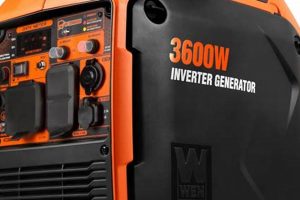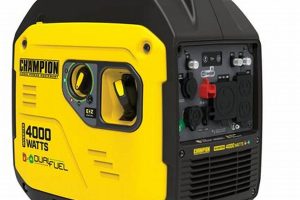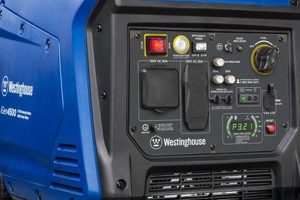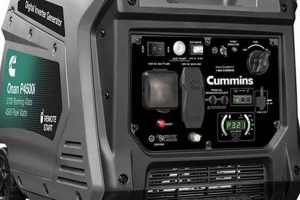Choosing a power source for outdoor activities, job sites, or emergency home backup often involves deciding between two main categories: conventional portable generators and inverter generators. Conventional units produce power at a constant speed, while inverter generators adjust their engine speed based on demand, resulting in greater fuel efficiency and quieter operation. For example, a conventional generator might consistently run at 3600 RPM, while an inverter generator will fluctuate its RPM to match the power load, perhaps running at 2000 RPM for a small load and increasing to 4000 RPM for a larger one.
The ability to provide reliable power independent of the electrical grid has made these generators invaluable for a variety of applications. From construction sites and recreational activities to disaster relief efforts, access to electricity can be essential. The development and refinement of inverter technology represent a significant advance, offering users more efficient and quieter power solutions. This evolution has broadened their applicability, making them suitable for sensitive electronics and environments where noise levels are a primary concern.
Understanding the distinctions between these two generator types is crucial for making an informed decision. The following sections will explore the core differences in terms of power output, fuel efficiency, noise levels, and overall cost, enabling consumers to choose the best option based on their specific needs and priorities.
Tips for Choosing Between Conventional and Inverter Generators
Selecting the appropriate generator requires careful consideration of various factors, including power requirements, budget constraints, and environmental impact. The following tips offer guidance for making an informed decision.
Tip 1: Evaluate Power Needs: Determine the wattage required to operate the intended devices. Consider both running wattage (power needed for continuous operation) and starting wattage (higher power needed briefly to start some appliances like refrigerators).
Tip 2: Assess Noise Tolerance: Inverter generators generally operate at lower noise levels. This factor becomes crucial in noise-sensitive environments such as campsites or residential areas.
Tip 3: Prioritize Fuel Efficiency: Inverter generators adjust their engine speed to match demand, leading to significant fuel savings and longer run times, especially with fluctuating loads.
Tip 4: Consider Portability: While both types can be portable, some inverter generators are designed for exceptional portability, featuring lightweight construction and compact designs.
Tip 5: Factor in Budget: Inverter generators typically have a higher initial cost. However, long-term fuel savings can offset this higher upfront investment.
Tip 6: Think About Electronics: Inverter generators produce cleaner power, making them suitable for sensitive electronic devices like laptops, smartphones, and medical equipment.
Tip 7: Examine Parallel Capability: Some generators offer parallel operation, allowing connection of multiple units for increased power output. Consider this if future power needs might increase.
By carefully considering these factors, consumers can select a generator that aligns with their specific requirements, whether prioritizing portability, quiet operation, fuel efficiency, or cost-effectiveness.
Equipped with this information, one can proceed to make an informed purchase decision.
1. Power Output
Power output represents a critical differentiator between conventional portable generators and inverter generators. Understanding the nuances of wattage capabilities is crucial for selecting a generator that effectively meets specific power demands. This section explores various facets of power output as they relate to each generator type.
- Rated Wattage (Running Watts)
Rated wattage indicates the continuous power a generator can supply. Conventional generators often offer higher rated wattages, suitable for powering multiple appliances or heavy-duty equipment simultaneously. Inverter generators typically have lower rated wattages, making them better suited for smaller loads or individual appliances. For instance, a construction site might require a conventional generator with a high rated wattage to power various tools, while a camper might find an inverter generator with a lower rated wattage sufficient for charging devices and running small appliances.
- Surge Wattage (Starting Watts)
Surge wattage refers to the brief, higher power output a generator can provide to start appliances with electric motors, such as refrigerators or air conditioners. These appliances require a surge of power to initiate operation. Conventional generators often provide substantial surge wattage. While inverter generators may have lower surge wattage, some models incorporate features to handle brief surges. Understanding surge wattage is critical for ensuring the chosen generator can start and run all intended devices.
- Power Output Stability
Conventional generators produce power at a fixed frequency, which can fluctuate under varying loads. Inverter generators, however, utilize advanced electronics to deliver stable, clean power similar to a household outlet. This consistent power quality is essential for sensitive electronics. For example, fluctuating power from a conventional generator could damage a computer, while the stable power from an inverter generator would be safe. This difference is a key consideration for powering delicate devices.
- Matching Power Needs to Generator Capacity
Accurately assessing power requirements is essential for selecting the appropriate generator type and size. Overloading a generator can lead to damage, while undersizing may result in insufficient power. Calculating the total wattage of intended devices and comparing it to the generator’s rated and surge wattage is paramount. Choosing a generator that comfortably handles the anticipated load ensures reliable operation and prevents equipment damage.
Considering these aspects of power output provides a clearer understanding of the capabilities of both conventional and inverter generators. This knowledge empowers informed decisions, enabling consumers to select a generator that precisely aligns with their specific power needs and intended applications. Ultimately, careful evaluation of power output characteristics contributes significantly to selecting the right generator for the job.
2. Fuel Efficiency
Fuel efficiency plays a significant role in the operational costs and environmental impact of portable generators. A comparative analysis between conventional and inverter generators reveals distinct differences in fuel consumption, impacting runtime and overall cost-effectiveness. Understanding these distinctions is essential for informed decision-making.
- Variable Speed Technology
Inverter generators leverage variable speed technology, adjusting engine speed to match the power demand. This dynamic adjustment optimizes fuel consumption, particularly at lower loads. Conventional generators, operating at a fixed speed, consume more fuel even when powering smaller loads. This difference can result in significant fuel savings over time, especially for users with fluctuating power needs. For instance, an inverter generator powering a few small appliances will consume less fuel than a conventional generator running at full speed to power the same load.
- Runtime and Refueling Frequency
Improved fuel efficiency translates to extended runtimes for inverter generators. This extended operation reduces the frequency of refueling, offering greater convenience and uninterrupted power supply. In scenarios requiring prolonged operation, such as extended camping trips or during power outages, the longer runtimes offered by inverter generators can be a significant advantage, minimizing interruptions and reducing the logistical challenges of frequent refueling.
- Environmental Impact
Lower fuel consumption contributes to a reduced environmental footprint. Inverter generators, by consuming less fuel, produce fewer emissions, making them a more environmentally friendly option. This factor is particularly relevant for users concerned about minimizing their impact on the environment. In areas with strict emissions regulations, inverter generators may be a preferable choice.
- Long-Term Cost Savings
While inverter generators often have a higher initial purchase price, the long-term fuel savings can offset this difference. Over the lifespan of the generator, reduced fuel consumption can lead to significant cost savings, particularly for frequent users. Calculating the total cost of ownership, including both the initial investment and ongoing fuel costs, provides a more comprehensive understanding of the long-term value proposition of each generator type.
Therefore, fuel efficiency is a key consideration when choosing between a conventional portable generator and an inverter generator. The variable speed technology of inverter generators results in significant fuel savings, longer runtimes, and reduced environmental impact. While the higher upfront cost of inverter generators might be a concern, the potential for long-term cost savings through reduced fuel consumption makes them an attractive option for many users. A comprehensive evaluation of fuel efficiency alongside other factors, such as power output and noise levels, ensures the selected generator aligns with individual needs and priorities.
3. Noise Levels
Noise levels represent a crucial factor in generator selection, particularly in environments where noise pollution is a concern. Significant differences exist between conventional and inverter generators regarding operational noise, impacting usability and suitability for various applications. This section explores the key aspects of noise generation and control related to each generator type.
- Decibel Levels and Human Perception
Conventional generators typically operate at higher decibel levels, often exceeding 70 dBA, comparable to the noise of a vacuum cleaner or a busy street. Inverter generators, due to their variable speed technology and advanced muffling, generally produce significantly lower noise levels, often in the 50-60 dBA range, similar to normal conversation. This difference can be substantial in noise-sensitive environments like campsites, residential areas, or during emergency backup power situations.
- Impact of Variable Speed Technology on Noise
The variable speed operation of inverter generators contributes significantly to their quieter performance. By adjusting engine speed to match the power demand, they avoid running at full throttle unnecessarily, reducing both fuel consumption and noise output. Conventional generators, operating at a constant speed, produce consistent noise levels regardless of the load. This constant noise can be disruptive, especially during periods of low power demand.
- Noise Reduction Features and Design
Manufacturers incorporate various noise reduction features in both generator types, including mufflers, sound-dampening enclosures, and vibration isolation mounts. However, inverter generators often benefit from more advanced noise reduction technologies, further minimizing their operational noise. These features enhance their suitability for noise-sensitive environments.
- Regulations and Considerations for Specific Environments
Certain environments, such as national parks and residential areas, have noise level regulations that restrict generator usage. Understanding these regulations is crucial for compliance and avoiding disturbances. Inverter generators, with their lower noise output, are often more likely to meet these requirements, allowing for operation in noise-restricted areas where conventional generators might be prohibited.
Therefore, noise levels are an important consideration when selecting a generator. The quieter operation of inverter generators makes them a preferred choice for noise-sensitive environments, while the higher noise output of conventional generators might be acceptable in other applications. Careful evaluation of noise levels alongside other factors ensures the chosen generator aligns with the specific needs and environmental considerations of the user. Ultimately, understanding the impact of noise on usability and compliance with regulations contributes to informed decision-making and responsible generator usage.
4. Power Quality
Power quality distinguishes conventional portable generators from inverter generators. Stable, clean power is essential for sensitive electronics and consistent appliance performance. This factor significantly influences generator suitability for various applications, particularly those involving delicate equipment or requiring precise power delivery.
- Total Harmonic Distortion (THD)
THD measures the distortion in the electrical output waveform. Conventional generators often produce higher THD, potentially harming sensitive electronics. Inverter generators, through advanced electronic circuitry, deliver a cleaner sine wave with lower THD, safer for delicate equipment like computers and medical devices. For instance, powering a computer with a high-THD generator could lead to data corruption or hardware damage, while an inverter generators low THD ensures safe, reliable operation.
- Voltage Regulation
Voltage regulation maintains consistent output voltage despite fluctuating loads. Inverter generators excel in voltage regulation, ensuring steady power delivery, crucial for appliances requiring precise voltage. Conventional generators may experience voltage fluctuations under varying loads, potentially affecting performance or causing damage. A refrigerator, for example, might malfunction or experience reduced lifespan due to voltage fluctuations from a conventional generator, whereas an inverter generator provides the stable voltage required for optimal operation.
- Frequency Stability
Frequency stability, measured in Hertz (Hz), indicates the consistency of the alternating current’s cycles per second. Inverter generators maintain a precise frequency, crucial for equipment sensitive to frequency variations, such as some audio equipment and electric clocks. Conventional generators may exhibit frequency fluctuations, impacting the performance of such devices. For example, a turntable might spin at an incorrect speed if powered by a generator with unstable frequency, whereas an inverter generator provides the stable frequency necessary for accurate playback.
- Clean Power for Sensitive Electronics
The clean power provided by inverter generators makes them ideal for powering sensitive electronics like laptops, smartphones, and medical equipment. The stable voltage, low THD, and precise frequency protect these devices from damage and ensure reliable performance. Conventional generators, with their potentially fluctuating power output, pose a greater risk to these sensitive devices. Therefore, in applications requiring powering delicate electronics, inverter generators are the preferred choice for ensuring safe and reliable operation.
Therefore, power quality is a paramount consideration when selecting between conventional and inverter generators. The clean, stable power delivered by inverter generators safeguards sensitive electronics and ensures consistent appliance performance. While conventional generators might suffice for less demanding applications, the superior power quality of inverter generators makes them essential for powering delicate equipment and ensuring reliable operation in various scenarios. Ultimately, understanding the nuances of power quality empowers informed decisions, aligning generator selection with specific power requirements and safeguarding valuable electronic devices.
5. Portability
Portability represents a critical factor influencing the selection between conventional portable generators and inverter generators. While both categories aim for transportability, significant differences exist in their size, weight, and overall ease of movement. These distinctions impact their suitability for various applications, ranging from recreational activities to emergency power supply. Understanding the nuances of portability within the context of these generator types empowers informed decision-making.
Conventional portable generators, while designed for transport, can be bulky and heavy, often requiring significant effort or assistance for movement. Their robust construction, intended for durability and high power output, contributes to their increased weight and size. In contrast, inverter generators often prioritize compact design and lightweight materials, enhancing their portability. This focus on ease of transport makes them ideal for applications requiring frequent movement, such as camping, tailgating, or providing power at remote job sites. For example, a contractor needing to move a generator frequently between different work locations might find the lighter weight and smaller footprint of an inverter generator significantly advantageous. Conversely, a homeowner seeking a stationary backup power solution for extended outages might prioritize the higher power output and rugged construction of a conventional portable generator over portability.
Several factors contribute to the portability differences between these generator types. Engine size and construction play a significant role; smaller, more compact engines contribute to lighter weight and reduced overall dimensions in inverter generators. Similarly, the use of lighter materials, such as aluminum alloys, in the construction of inverter generator frames further enhances portability. Handle design and wheel configuration also influence ease of movement. Inverter generators often feature ergonomic handles and smooth-rolling wheels, facilitating transport over various terrains. Ultimately, careful consideration of portability requirements, alongside power needs and other relevant factors, ensures selection of the optimal generator for specific applications. Understanding the practical implications of portability differences empowers users to choose a generator that aligns seamlessly with their anticipated usage scenarios.
6. Cost
Cost represents a significant factor influencing the decision-making process when choosing between a portable generator and an inverter generator. Understanding the various cost components, including initial purchase price, operating costs, and potential long-term savings, is crucial for making an informed investment. A comprehensive cost analysis requires considering both immediate expenses and long-term value.
- Initial Purchase Price
Inverter generators typically command a higher initial purchase price compared to conventional portable generators with similar power output. This price difference stems from the advanced technology incorporated in inverter generators, including the variable speed engine control, sophisticated electronics for power regulation, and noise reduction features. For example, a 2000-watt inverter generator might cost significantly more upfront than a conventional generator with the same wattage rating. Consumers must weigh this initial investment against potential long-term savings.
- Operating Costs (Fuel and Maintenance)
Operating costs encompass fuel consumption and routine maintenance. Inverter generators, due to their variable speed technology, generally consume less fuel than conventional generators, especially at lower loads. This reduced fuel consumption translates to lower operating costs over time. Maintenance requirements, including oil changes and air filter replacements, are generally comparable between the two generator types. However, the more complex electronic components within inverter generators could potentially incur higher repair costs if they malfunction.
- Long-Term Value and Return on Investment
Assessing long-term value requires considering the lifespan of the generator and the cumulative operating costs. While the higher initial purchase price of an inverter generator represents a larger upfront investment, the potential for long-term fuel savings can offset this cost over time. For frequent users or those requiring extended runtimes, the fuel efficiency of inverter generators can contribute to a significant return on investment. Conversely, for occasional use or applications requiring high power output, a conventional generator might offer a more cost-effective solution.
- Resale Value
Resale value can also contribute to the overall cost assessment. Inverter generators, due to their advanced technology and generally longer lifespans, may retain a higher resale value compared to conventional generators. This factor can be relevant for consumers who anticipate upgrading their generator in the future or who prioritize recouping a portion of their investment.
Therefore, understanding the various cost components associated with portable and inverter generators is essential for making a financially sound decision. While inverter generators typically have a higher initial purchase price, their fuel efficiency and potential for higher resale value can contribute to long-term cost savings. Conversely, conventional generators offer a lower upfront cost, which might be more suitable for occasional use or applications prioritizing high power output. A comprehensive cost analysis, considering both immediate expenses and long-term value, empowers consumers to choose a generator that aligns with their budget and anticipated usage patterns.
Frequently Asked Questions
This section addresses common inquiries regarding the distinctions between portable and inverter generators, aiming to provide clear and concise answers for informed decision-making.
Question 1: Which generator type is more suitable for sensitive electronics?
Inverter generators are generally preferred for sensitive electronics due to their cleaner power output, characterized by lower total harmonic distortion (THD) and stable voltage and frequency.
Question 2: How does fuel efficiency compare between the two generator types?
Inverter generators typically offer superior fuel efficiency due to their variable speed technology, adjusting engine speed to match power demand, resulting in lower fuel consumption, especially at partial loads. Conventional generators operate at a fixed speed, consuming more fuel regardless of the load.
Question 3: Which generator type is generally quieter?
Inverter generators are significantly quieter than conventional generators, owing to their variable speed operation, advanced mufflers, and noise-reducing enclosures. This makes them suitable for noise-sensitive environments.
Question 4: What are the key cost considerations when choosing between the two types?
Inverter generators typically have a higher initial purchase price. However, their fuel efficiency can lead to lower operating costs over time. Conventional generators offer a lower upfront cost but may incur higher fuel expenses, especially with frequent or prolonged use.
Question 5: Which generator type is better suited for powering high-wattage appliances?
Conventional generators often offer higher wattage output, making them suitable for powering multiple high-wattage appliances simultaneously. While some inverter generators can be paralleled to increase output, conventional generators typically offer higher individual wattage capacities.
Question 6: What are the primary portability considerations?
Inverter generators generally excel in portability due to their smaller size, lighter weight, and compact design. Conventional generators can be larger and heavier, potentially requiring more effort for transport.
Careful consideration of these factors, alongside specific power requirements and anticipated usage scenarios, facilitates selection of the most appropriate generator type for individual needs.
For further inquiries or specific application guidance, consulting with a qualified power equipment specialist is recommended.
Portable Generator vs Inverter Generator
Selecting between a portable generator and an inverter generator requires careful consideration of several key factors. This comparison has highlighted the core distinctions, including power output, fuel efficiency, noise levels, power quality, portability, and cost. Conventional portable generators often offer higher wattage output and a lower initial purchase price, making them suitable for applications requiring substantial power and where budget is a primary concern. However, their higher noise levels and lower fuel efficiency can be drawbacks. Inverter generators, while typically more expensive upfront, excel in fuel efficiency, quiet operation, and clean power delivery, making them ideal for powering sensitive electronics and use in noise-sensitive environments.
Ultimately, the optimal choice depends on the specific needs and priorities of the user. Careful evaluation of power requirements, budget constraints, anticipated usage scenarios, and environmental considerations will guide the selection process. Understanding the trade-offs between power output, fuel efficiency, noise levels, and cost empowers informed decision-making, ensuring the chosen generator effectively meets the demands of the intended application, whether it’s powering a job site, providing backup power during an outage, or enabling enjoyment of outdoor recreational activities.






